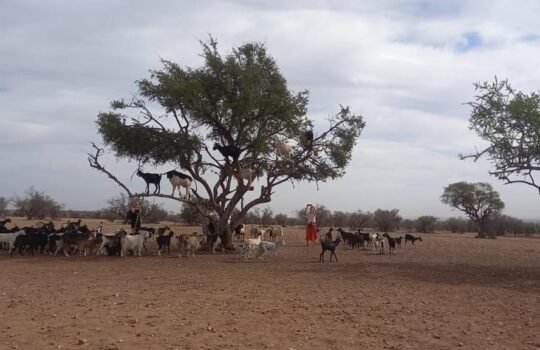Nestled in the arid regions of southwestern Morocco lies the majestic argan tree (Argania spinosa), a species that has flourished for millions of years. This ancient tree, often referred to as the “Tree of Life,” plays a crucial role in the local ecosystem and the livelihoods of many Moroccan communities. In this article, we will explore the significance of the argan tree, its unique characteristics, and its contributions to both the environment and the economy.
The Unique Characteristics of the Argan Tree
The argan tree is a resilient and hardy species, well-adapted to the harsh, semi-desert environment of Morocco. Here are some of its unique characteristics:
- Longevity: Argan trees can live up to 200 years, providing sustenance and shelter for generations.
- Deep Roots: The tree’s extensive root system allows it to access water deep underground, helping it survive in arid conditions and prevent soil erosion.
- Thorny Branches: The tree is covered in thorny branches, which protect it from herbivores and provide a natural defense mechanism.
Ecological Significance
The argan tree plays a vital role in the local ecosystem, offering numerous environmental benefits:
- Soil Conservation: The deep root system of the argan tree helps anchor the soil, preventing erosion and desertification in the region.
- Biodiversity: The tree provides a habitat for various plant and animal species, contributing to the region’s biodiversity.
- Carbon Sequestration: Argan trees absorb carbon dioxide from the atmosphere, helping to mitigate the effects of climate change.
Economic Importance
The argan tree is not only an ecological asset but also a significant economic resource for the people of Morocco:
- Argan Oil Production: The tree’s fruit contains kernels from which argan oil is extracted. This oil is highly valued for its nutritional, cosmetic, and medicinal properties.
- Employment Opportunities: The argan oil industry provides jobs for many local women, who are traditionally responsible for harvesting the fruit and processing the oil. This industry empowers women and supports rural communities.
- Sustainable Development: The cultivation and production of argan oil are often conducted through cooperatives that prioritize sustainable practices, ensuring the long-term health of the argan forests.
Cultural Significance
The argan tree holds a special place in Moroccan culture and traditions:
- Traditional Medicine: Argan oil has been used for centuries in traditional Moroccan medicine to treat various ailments, including skin conditions and digestive issues.
- Culinary Delicacy: In Moroccan cuisine, argan oil is a prized ingredient, used in salads, dips, and traditional dishes like amlou, a nutty spread made with almonds and honey.
- Cultural Heritage: The knowledge and practices related to argan oil production have been passed down through generations, preserving the cultural heritage of the region.
Challenges and Conservation Efforts
Despite its importance, the argan tree faces several challenges:
- Overexploitation: The high demand for argan oil has led to overharvesting, putting pressure on the argan forests.
- Climate Change: Changing climate patterns and prolonged droughts threaten the survival of the argan tree.
- Deforestation: Agricultural expansion and urbanization have led to the loss of argan tree habitats.
To address these challenges, various conservation efforts have been implemented:
- Reforestation Projects: Initiatives to plant new argan trees and restore degraded areas are underway to ensure the sustainability of the argan forests.
- Sustainable Harvesting: Promoting sustainable harvesting practices helps protect the trees and maintain the quality of argan oil.
- Research and Education: Ongoing research and education programs aim to raise awareness about the importance of the argan tree and its conservation.
Conclusion
The argan tree is a natural wonder that holds immense ecological, economic, and cultural significance. Its resilience and versatility make it a vital resource for the people of Morocco and an essential component of the region’s landscape. By supporting sustainable practices and conservation efforts, we can help preserve this majestic tree for future generations to appreciate and benefit from. Embrace the legacy of the argan tree and recognize its unparalleled contributions to our world.






